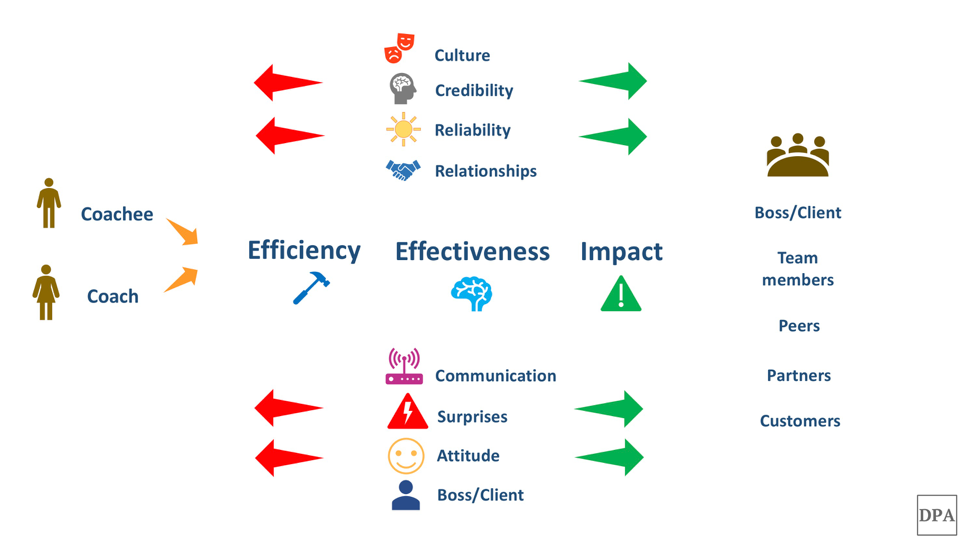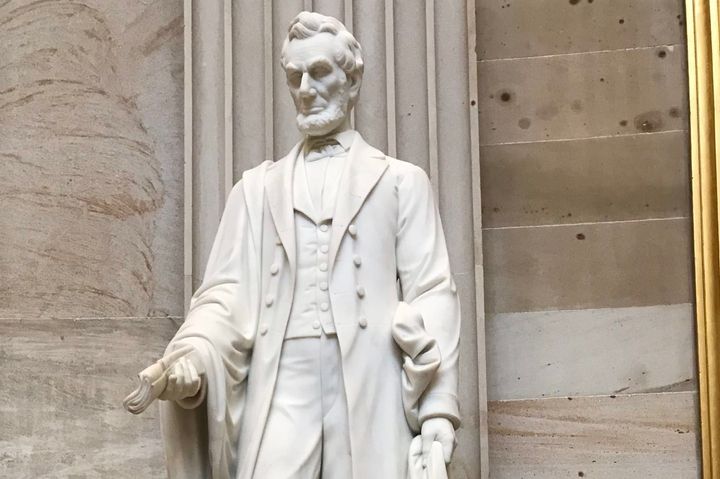Eleven ways we make sure executive coaching delivers value

Executive coaches work with their coachees to move them from where they are now to where they want to be in the future. Coaching focuses on the behaviors necessary to forward action. While there is some time spent looking backward for understanding, the majority of the time and effort is spent building a compelling future.
Three improvement areas
There are three valuable improvement areas for a coachee, a client (often the coachee’s boss), and an organization. These are efficiency, effectiveness, and impact.
Notably, none of these is about the value of the person; instead, each encompasses the person’s behaviors that are either helping or blocking them from unlocking their talents and contributing their potential.
The shared goal is to evaluate what’s working and what’s not and to discuss and develop an action plan that is worthwhile and doable.
Efficiency often centers around the person’s ability to delegate, manage time, and limit the non-essential activities that crowd out the essential ones. It is especially helpful in managing processes.
Effectiveness also impacts task delegation, specifically how broadly and deeply the leader can engage her direct reports and the wider team to handle issues as they arise without frequent intervention. It shows up in stressful situations, and in delicate confrontations that lead to resolutions that work for the team and leave relationships stronger rather than weaker. It is especially helpful in managing people.
The impact has a broad range encompassing bench development, employee engagement, customer loyalty, performance on key, milestone-based metrics; and overall business results. In simplest terms, it asks how the behavioral improvement impacts the organization in ways that matter to its owners, executives, team members, and customers.
Improving efficiency, effectiveness, or impact creates the measuring stick for the coaching engagement. Importantly, the boss, team members, peers, partners, and customers are the ones who measure that improvement.
Eight factors impacting improvement
The improvement path has several contributing factors that either propel the coachee forward or bog them down. While not a complete list, these eight elements help determine whether the coachee is successful or falls short of their objectives.
Culture. The combined behaviors and attitudes of the organization serve to support or undermine improvement. In safe cultures, people have the opportunity to make mistakes, apologize, and grow. Here, the coachee can reveal his vulnerability, use the phrase “I don’t know” liberally, and practice new behaviors.
In unsafe cultures, vulnerability is treated as weakness and admitting to a lack of knowledge may be raising the flag of incompetence to ignorant managers.
Credibility. An element of trust earned from others by being experts in our field. It doesn’t require perfection, but it does require a continuous improvement mindset and acknowledging we are always trying to master our craft.
Many argue that credibility is table stakes for a senior leadership position, but some leaders make it into their roles for other reasons, making credibility anything but a foregone conclusion.
Reliability is an element of trust earned over time. We don’t immediately know whether a new team member is reliable. Only through repeated promises and consistent actions is that proved by any of us.
A leader who is unreliable cannot effectively influence others for any length of time. Such behavior marginalizes us and leads to obsolescence.
Relationships. How we treat others lies at the foundation of effective leadership. No leader hasn’t bruised some feelings along the way, or worse. To improve our performance in the trio requires us to apologize, mend fences, and move forward with more productive dialogue and shared objectives.
Excluding unbecoming conduct and fraudulent activities, most unhelpful behaviors are changeable if the key stakeholders in the organization are willing to give the coachee a fair chance to improve.
There is inherent value in improving these behaviors anyway, even if the coachee ends up practicing them elsewhere. Sometimes the damage to relationships is too significant and forgiveness too late. Fortunately, this is a rare occurrence.
Communication. I believe that nearly all work issues arise from a communication breakdown. There is scarcely a single skill we can master that has more power than this one. Offhandedly dismissed as apparent, we become unwilling or unable to have a discussion we believe too complicated or sensitive.
In cultures that make it safe for people to speak, reward dialogue and collaboration, and teach and reinforce communication skills, people engage, thrive, and perform at higher levels. The more common situation, where people feel unsafe to speak, has precisely the opposite result on our people, work environment, and results.
Surprises. Often, during a coaching engagement, things change in the organization as bosses move, org charts shift, acquisitions occur, CEOs change their minds, and positive and negative surprises provide the catalyst to adjust focus.
Surprises increase coachee stress, with the urgent and acute surprise crowding out the work that benefits the long-term good of the client. The coach can use such shocks to highlight and practice new behaviors and create a real-time learning lab for the coachee.
Attitude. We spend time refining recruiting and interviewing processes to make sure we hire people with the right attitude. It is equally important to monitor and adjust our perspectives as we build our leadership skills.
A coachee’s view is a critical component of improving their efficiency, effectiveness, and impact. Sometimes we have the agility to avoid getting punched in the face. When we aren’t as fortunate, we turn to the skill of resilience to help us get up and moving again.
We grow when we experience setbacks as a learning opportunity rather than a verdict on our self-worth. When we are open to feedback and willing to take on the difficult task of changing some habits that don’t serve us well or any more, we learn and change.
Boss/Client. A supportive boss who wants the coachee to grow is an integral part of the success formula. For obvious reasons, a boss can provide support and reinforcement for new behaviors and can also create an environment that impedes personal and professional growth.
Takeaway: By evaluating what’s missing from the efficiency, effectiveness, and impact equation, the coach and coachee can determine where to focus their energy. Early awareness of the eight elements impacting improvement help the coach and coachee quickly identify areas of support and address issues as they arise. The work environment will create uncertainty, and having a clear strategy to navigate the coaching relationship creates an environment for successful change.


